Frank Gehry: Exploring Deconstruction
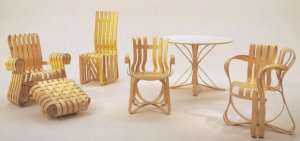
Frank Gehry isn’t only a renowned architect. He’s also an incredible furniture designer on an unending quest to explore deconstruction. It’s a common theme in his work; his offices are the perfect example.
Gehry is among the top 10 most prestigious architects of the 20th century. In Spain, he’s erected emblematic buildings such as the Guggenheim Museum in Bilbao and the Hotel Marqués de Riscal.
He’s an architect that works from an artistic perspective. In his eyes, architecture is a form of artistic expression. In a sense, rather than creating buildings, he creates functional sculptures.
A major deconstructive architect, Gehry broke into the furniture design scene at the ends of the 60s. He soon made a name for himself with lines such as his Easy Edges or Experimental Edges.
In the beginning
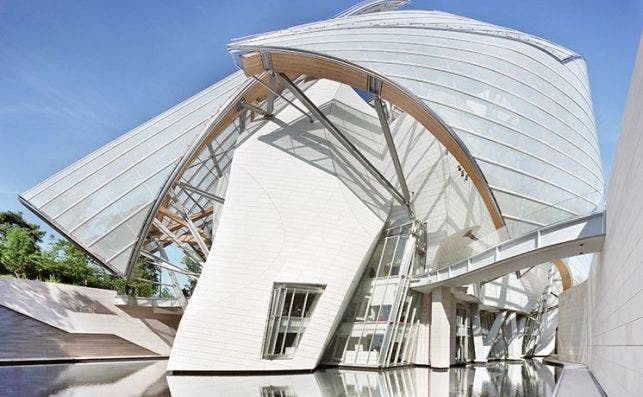
Frank Owen Goldberg (his real name) was born on February 28 in Ontario, Canada and he has been living in Los Angeles since 1947. He graduated from the University of Southern California with a degree in architecture in 1954. He then studied urban planning a few years later at the Harvard Graduate School of Design.
Around 1961, he moved to Paris with his entire family, where he worked in André Rémondet’s atelier. During his time with Rémondet, Gehry learned about the works of European architects like Le Corbusier.
In 1962, Gehry returned to Los Angeles to start his own company, Frank O. Gehry & Associates. The company kicked off with a series of projects and in 1979, created the emblematic Frank O. Gehry House.
The Frank O. Gehry House played a key role in his future success. Through the project, he set up a successful foundation as an architect with a unique style.
From square one, Gehry knew how to manage perspectives, curves, and materials like an expert in his architecture projects. On a different note, he has a preference for materials such as scrap metal, restored metal and glass.
Gehry explores deconstruction, which is an architectonic movement that seeks to break through the basic principals of architecture. Flowing with the deconstruction wave, he follows a non-linear design and uses elements that suggest constant movement to create visual controlled chaos.
Frank Gehry, exploring deconstruction: biggest works
Guggenheim Museum, Bilbao
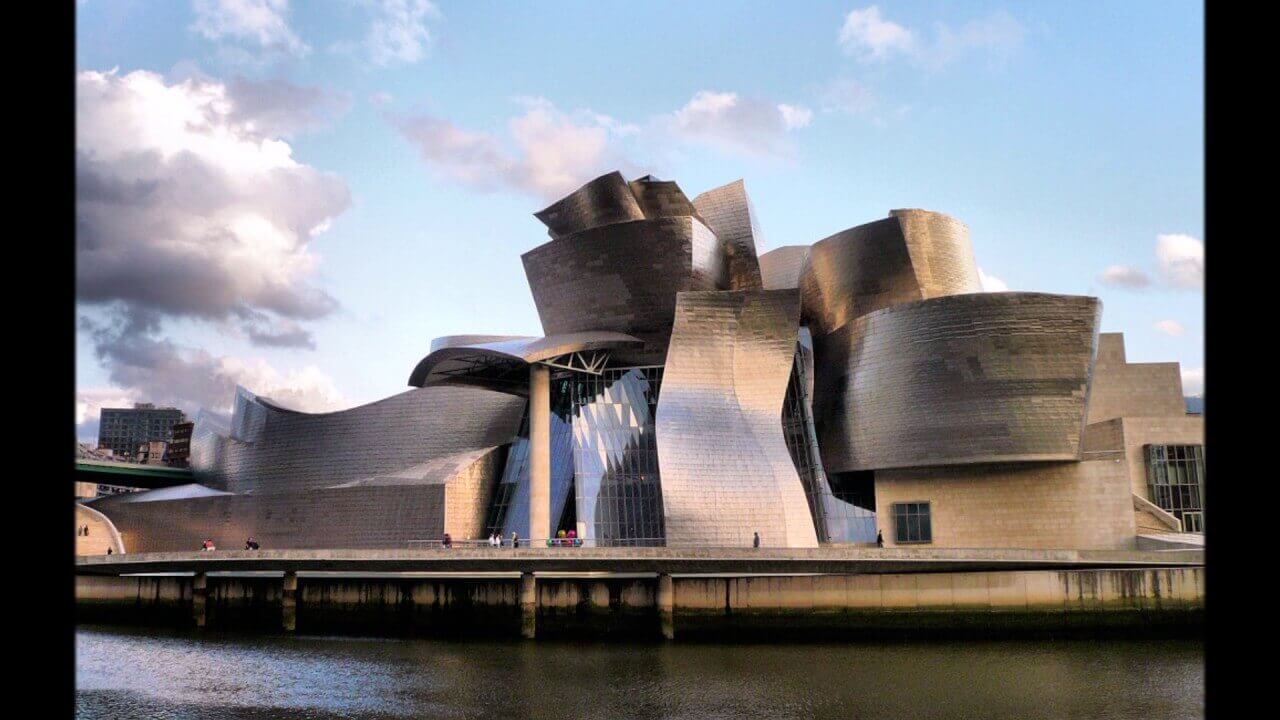
The Guggenheim Museum, located in Bilbao, Spain, is a prime example of 20th-century vanguard architecture. Featuring an innovative design, the building brought life back to the Bilbao estuary.
Gehry applied his unique style to the Guggenheim’s design. Along with his personal style, he drew inspiration from the textures of the scales on a fish. As a result, a work of art was born. Just as with most of his works, the Guggenheim building has no geometric sense.
Hotel Marqués de Riscal, La Rioja, Spain

This project is another great example of Gehry’s sculptural architecture with a distinct, personal style. The lines are winding and curved, creating a complex form.
The building is covered in a titanium layer varying in color between pink, gold, and silver. These colors, along with the building’s curves, create reddish reflections similar to the hues of Marqués de Riscal wine.
Walt Disney Concert Hall, Los Angeles, United States
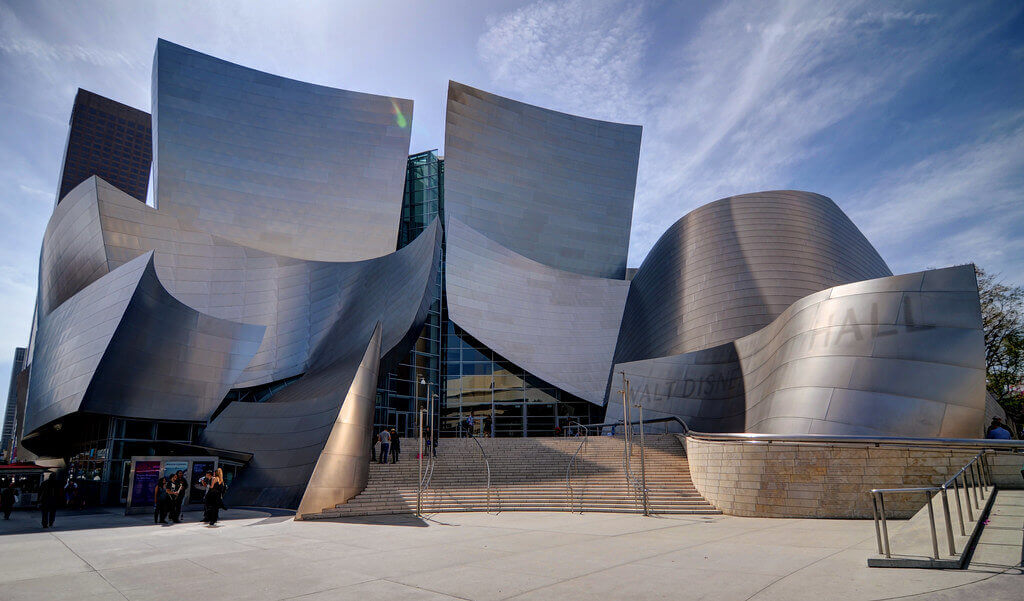
The Walk Disney Concert Hall flaunts an extravagant form, showing off another style of this talented Canadian architect. The lines seem to defy the laws of symmetry and harmony in traditional architecture. The exterior evokes a ship ready to set sail.
The building is made of a series of interconnected parts that are covered in a steel shell. The volumes vary in size; some are orthogonal while others have an organic shape and wavy surface. The glass surfaces serve as a connection between the different parts.
Architecture should speak of its time and place, but yearn for timelessness.
–Frank Gehry–
The work of Frank Gehry, exploring deconstruction
Frank Gehry is an architect who loves curves and winding lines. But he also explores different uses of diverse materials. This constant exploration leads him to design furniture pieces with materials that give him the freedom to experiment.
His armchair and chair from the line Power Play are perfect examples. For the collection, he used steam to mold beech wood. Another interesting example is his Wiggle collection, where who used ribbed cardboard and wood to create his furniture pieces.
Frank Gehry Furniture: Power Play chair
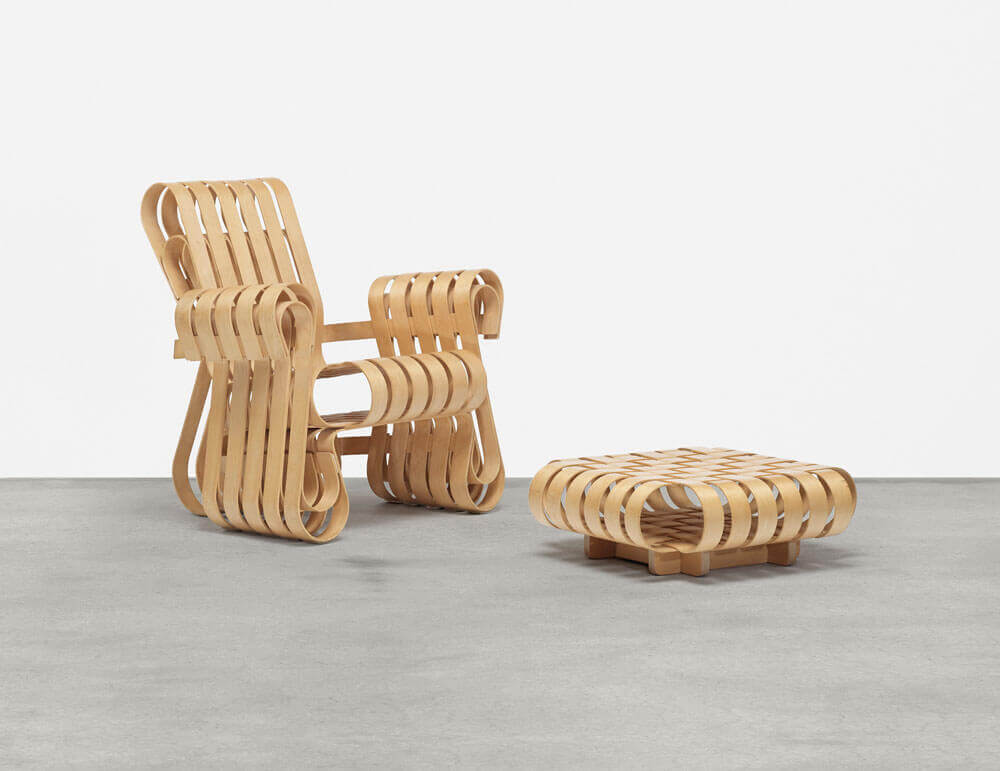
The Knoll firm invited Gehry to design vanguard furniture and the architect dove into his experiments with new ideas and ways to use material and structure.
Then in 1991, Gehry unveiled his collection of laminated beechwood chairs and tables. The public saw them for the first time at the New York Museum of Modern Art.
He explained that the chairs were inspired by the wooden structure of apple crates, which he often played with as a child. Thus, he created them with a hint of nostalgia.
Frank Gehry furniture: Wiggle chair
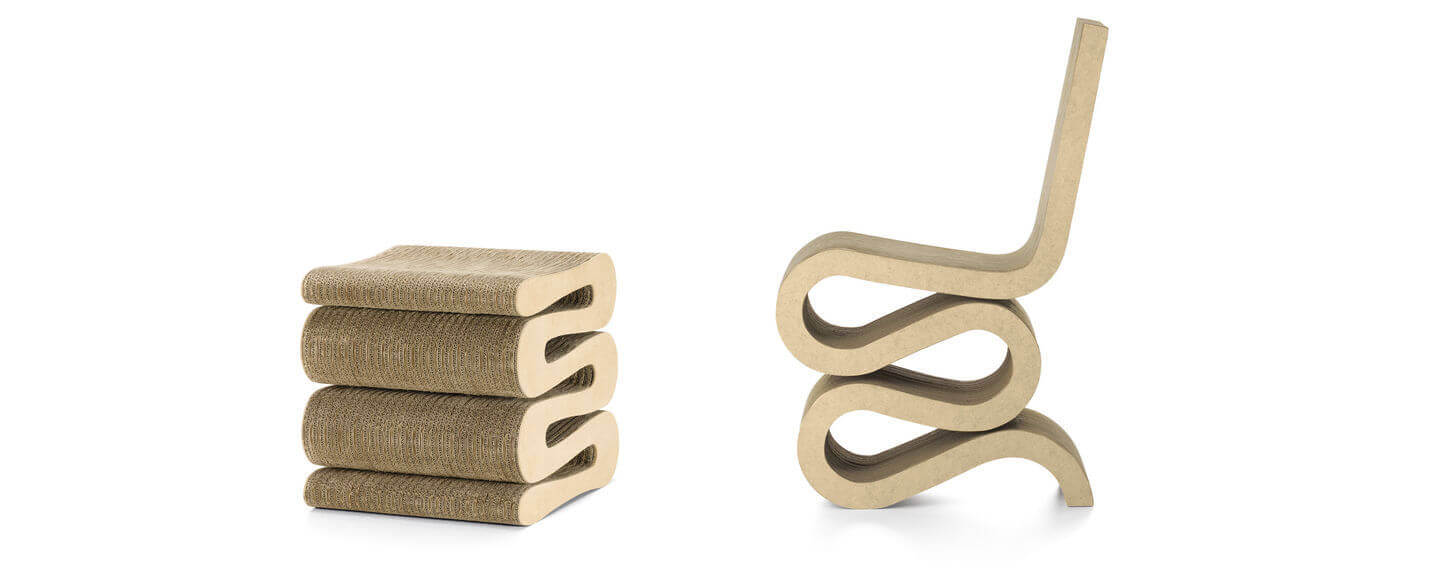
The Wiggle chair is a furniture design classic thanks to its unique shape and materials. It’s actually an internationally celebrated design.
The chair features a set of curves, which Gehry created with ribbed cardboard. Though a light material, the chair is sound and stable, not seeming at all like cardboard to its user.
The design dates back to 1972 and was meant to be a sculpture rather than a piece of furniture. But despite its original purpose, the company Vitra brought it to the market in 1997.
The chair is part of the Easy Edges collection, which features ribbed cardboard furniture and sculptures. Gehry also designed a stool to match the chair as well.
Frank Gehry furniture is an amazing response to the deconstructivist exploration that embodies his architecture. His designs have passed on from his buildings to furniture pieces true to the art of deconstruction.
Frank Gehry isn’t only a renowned architect. He’s also an incredible furniture designer on an unending quest to explore deconstruction. It’s a common theme in his work; his offices are the perfect example.
Gehry is among the top 10 most prestigious architects of the 20th century. In Spain, he’s erected emblematic buildings such as the Guggenheim Museum in Bilbao and the Hotel Marqués de Riscal.
He’s an architect that works from an artistic perspective. In his eyes, architecture is a form of artistic expression. In a sense, rather than creating buildings, he creates functional sculptures.
A major deconstructive architect, Gehry broke into the furniture design scene at the ends of the 60s. He soon made a name for himself with lines such as his Easy Edges or Experimental Edges.
In the beginning

Frank Owen Goldberg (his real name) was born on February 28 in Ontario, Canada and he has been living in Los Angeles since 1947. He graduated from the University of Southern California with a degree in architecture in 1954. He then studied urban planning a few years later at the Harvard Graduate School of Design.
Around 1961, he moved to Paris with his entire family, where he worked in André Rémondet’s atelier. During his time with Rémondet, Gehry learned about the works of European architects like Le Corbusier.
In 1962, Gehry returned to Los Angeles to start his own company, Frank O. Gehry & Associates. The company kicked off with a series of projects and in 1979, created the emblematic Frank O. Gehry House.
The Frank O. Gehry House played a key role in his future success. Through the project, he set up a successful foundation as an architect with a unique style.
From square one, Gehry knew how to manage perspectives, curves, and materials like an expert in his architecture projects. On a different note, he has a preference for materials such as scrap metal, restored metal and glass.
Gehry explores deconstruction, which is an architectonic movement that seeks to break through the basic principals of architecture. Flowing with the deconstruction wave, he follows a non-linear design and uses elements that suggest constant movement to create visual controlled chaos.
Frank Gehry, exploring deconstruction: biggest works
Guggenheim Museum, Bilbao

The Guggenheim Museum, located in Bilbao, Spain, is a prime example of 20th-century vanguard architecture. Featuring an innovative design, the building brought life back to the Bilbao estuary.
Gehry applied his unique style to the Guggenheim’s design. Along with his personal style, he drew inspiration from the textures of the scales on a fish. As a result, a work of art was born. Just as with most of his works, the Guggenheim building has no geometric sense.
Hotel Marqués de Riscal, La Rioja, Spain

This project is another great example of Gehry’s sculptural architecture with a distinct, personal style. The lines are winding and curved, creating a complex form.
The building is covered in a titanium layer varying in color between pink, gold, and silver. These colors, along with the building’s curves, create reddish reflections similar to the hues of Marqués de Riscal wine.
Walt Disney Concert Hall, Los Angeles, United States

The Walk Disney Concert Hall flaunts an extravagant form, showing off another style of this talented Canadian architect. The lines seem to defy the laws of symmetry and harmony in traditional architecture. The exterior evokes a ship ready to set sail.
The building is made of a series of interconnected parts that are covered in a steel shell. The volumes vary in size; some are orthogonal while others have an organic shape and wavy surface. The glass surfaces serve as a connection between the different parts.
Architecture should speak of its time and place, but yearn for timelessness.
–Frank Gehry–
The work of Frank Gehry, exploring deconstruction
Frank Gehry is an architect who loves curves and winding lines. But he also explores different uses of diverse materials. This constant exploration leads him to design furniture pieces with materials that give him the freedom to experiment.
His armchair and chair from the line Power Play are perfect examples. For the collection, he used steam to mold beech wood. Another interesting example is his Wiggle collection, where who used ribbed cardboard and wood to create his furniture pieces.
Frank Gehry Furniture: Power Play chair

The Knoll firm invited Gehry to design vanguard furniture and the architect dove into his experiments with new ideas and ways to use material and structure.
Then in 1991, Gehry unveiled his collection of laminated beechwood chairs and tables. The public saw them for the first time at the New York Museum of Modern Art.
He explained that the chairs were inspired by the wooden structure of apple crates, which he often played with as a child. Thus, he created them with a hint of nostalgia.
Frank Gehry furniture: Wiggle chair

The Wiggle chair is a furniture design classic thanks to its unique shape and materials. It’s actually an internationally celebrated design.
The chair features a set of curves, which Gehry created with ribbed cardboard. Though a light material, the chair is sound and stable, not seeming at all like cardboard to its user.
The design dates back to 1972 and was meant to be a sculpture rather than a piece of furniture. But despite its original purpose, the company Vitra brought it to the market in 1997.
The chair is part of the Easy Edges collection, which features ribbed cardboard furniture and sculptures. Gehry also designed a stool to match the chair as well.
Frank Gehry furniture is an amazing response to the deconstructivist exploration that embodies his architecture. His designs have passed on from his buildings to furniture pieces true to the art of deconstruction.







